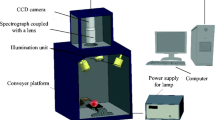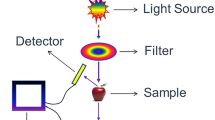Abstract
Fruit maturity indexes are crucial in harvest time determination and commercial context. The harvest time of apples, matching the desired commercial characteristics, is assessed through starch–iodine test in practice. Fruit halves are dipped into iodine solution and patterns are visually evaluated by experts comparing them to reference charts. Aim of the work was to study the relationships of near infrared (NIR) spectral images (1,000–1,700 nm), starch/starch-free patterns visually assessed and RGB color images. Spectral images of 88 Golden Delicious Klon B apples were sampled at seven different maturity stages. Partial least-squares discriminant analysis (PLSDA) technique was used on hyper-spectral NIR images to classify single pixels using its NIR reflectance spectrum. The response variable (i.e. the classification for each pixel) was identified through the matching of single pixel obtained with the color images, segmented in two classes (starch and starch-free), and the NIR hyper-spectral matrix. Mean hyper-spectral classification obtained through PLSDA modeling on individual apple correctly classified 80.81% of the total pixels, while the unique model, i.e. a single model including all the fruits, resulted in 66.33%. In the latter case, the relationship with the RGB classification showed high values (Pearson correlation coefficient r = 0.95). The present work shows the feasibility of NIR imaging spectroscopy as a tool for apple fruit maturity determination, avoiding expert’s subjective interpretation by traditional starch index assignments.







Similar content being viewed by others
References
Blanpied, G. D., & Silsby, K. J. (1992). Predicting harvest date windows for apples. Cornell Cooperative Extension Publication. Information Bulletin, 221, 1–12.
BonifaziSerrantiMenesatti, G.S.P. (2005). Hyperspectral imaging based techniques in ornamental stone characterization. In Y.-R. Chen (Ed.), Proceedings of the SPIE (The International Society for Optical Engineering) on Optical Sensors and Sensing Systems for Natural Resources and Food Safety and Quality, Vol. 5996 (pp. 203–214). Bellingham, WA: SPIE (International Society for Optical Engineering).
Brookfield, P., Murphy, P., Harker, R., & MacRae, E. (1997). Starch degradation and starch pattern indices; interpretation and relationship to maturity. Postharvest Biology and Technology, 1(I), 23–30. doi:10.1016/S0925-5214(97)01416-6.
Costa, C., Aguzzi, J., Menesatti, P., Antonucci, F., Rimatori, V., & Mattoccia, M. (2008b) Shape analysis of different populations of Ruditapes decussatus and R. philippinarum in relation to their geographical structure. Journal of Zoology. doi:10.1111/j.1469-7998.2008.00469.x.
Costa, C., Angelini, C., Scardi, M., Menesatti, P. & Utzeri, C. (2008c) Using image analysis on the ventral colour pattern in Salamandrina perspicillata (Savi, 1821) (Amphibia, Salamandridae) to discriminate among populations. Accepted by Biological Journal of the Linnean Society, in press.
Costa, C., Menesatti, P., Aguzzi, J., D’Andrea, S., Antonucci, F., Rimatori, V., et al. (2008a). External shape differences between sympatric populations of commercial clams Tapes decussatus and T. philippinarum. Food and Bioprocess Technology. doi:10.1007/s11947-008-0068-8.
Crisosto, C. H. (1994). Stone fruit maturity indices: a descriptive review. Postharvest News and Information, 5(6), 65–68.
Dasarathy, B. V. (1995). Nearest neighbor (NN) norms: NN pattern classification techniques. Los Alamitos, CA, USA: IEEE Computer Society.
Herold, B., Truppel, I., Zude, M., & Geyer, M. (2005). Spectral measurements on ‘Elstar’ apples during fruit development on the tree. Biosystems Engineering, 91(2), 173–182. doi:10.1016/j.biosystemseng.2005.03.005.
Juan, X., & Baerdemaeker, J. (2005). Bruise detection on ‘Jonagold’ apples using hyperspectral imaging. Postharvest Biology and Technology, 37(2), 152–162. doi:10.1016/j.postharvbio.2005.02.015.
Knee, M. (1993). Pome fruits. In G. B. Seymour, et al. (Ed.), Biochemistry of fruit ripening (pp. 325–346). New York, USA: Chapman and Hall.
Mehl, P., Chen, Y., Kim, M., & Chan, D. (2004). Development of hyperspectral imaging technique for the detection of apple surface defects and contaminations. Journal of Food Engineering, 61, 67–81. doi:10.1016/S0260-8774(03)00188-2.
Menesatti, P., D’Andrea, S., & Costa, C. (2007). Spectral and thermal imaging for meat quality evaluation. In C. Lazzaroni, et al. (Ed.), New developments in evaluation of carcass and meat quality in cattle and sheep, 123 (pp. 115–134). Wageningen, The Netherlands: Wageningen Academic.
Mitchell, F. G., Mayer, G., Saenz, M., Slaughter, D., Johnson, R. S., Biasi, B., et al. (1991). Selecting and handling high quality stone fruit for fresh market. In: 1991 Research reports for California peaches and nectarines, California tree fruit agreement, (pp. 1–11). Sacramento, California, USA.
Nicolai, B., Lotze, E., Peirs, A., Scheerlinck, N., & Theron, K. (2006). Non-destructive measurement of bitter pit in apple fruit using NIR hyperspectral imaging. Postharvest Biology and Technology, 40, 1–6. doi:10.1016/j.postharvbio.2005.12.006.
Noh, H. K., Peng, Y., & Lu, R. (2007). Integration of hyperspectral reflectance and fluorescence imaging for assessing apple maturity. Transactions of the ASABE, 50(3), 963–971.
Olmo, M., Nadas, A., & García, J. M. (2000). Nondestructive methods to evaluate maturity level of oranges. Journal of Food Science, 65(2), 365–369. doi:10.1111/j.1365-2621.2000.tb16008.x.
Peirs, A., Scheerlinck, N., Baerdemaeker, J., & Nicolai, B. (2003). Starch index determination of apple fruit by means of a hyperspectral near infrared reflectance imaging system. Journal of Near Infrared Spectroscopy, 11(5), 379–389.
Peirs, A., Scheerlinck, N., Perez, A. B., Jancsok, P., & Nicolai, B. M. (2002). Uncertainty analysis and modelling of the starch index during apple fruit maturation. Postharvest Biology and Technology, 26(2), 199–207. doi:10.1016/S0925-5214(02)00038-8.
Peng, Y. K., & Lu, R. F. (2006). Improving apple fruit firmness predictions by effective correction of multispectral scattering images. Postharvest Biology and Technology, 41, 266–274. doi:10.1016/j.postharvbio.2006.04.005.
Reid, M. S. (1992). Maturation and maturity indices. In J. H. La Rue, & R. S. Johnson (Eds.), Peaches, plums and nectarines: growing and handling for fresh market, 3331 (pp. 21–28). California, USA: University of California Department of Agriculture and Natural Resources.
Sabatier, R., Vivein, M., & Amenta, P. (2003). Two approaches for discriminant partial least square. In M. Schader, et al. (Ed.), Between data science and applied data analysis. Berlin, Germany: Springer.
Sjöström, M., Wold, S., & Söderström, B. (1986). PLS discrimination plots. In E. S. Gelsema, & L. N. Kanals (Eds.), Pattern recognition in practice II. Amsterdam, The Netherlands: Elsevier.
Smith, R. B., Lougheed, E. C., Franklin, E. W., & McMillan, I. (1979). The starch iodine test for determining stage of maturation in apples. Canadian Journal of Plant Science, 59, 725–735.
Xing, J., Bravo, C., Jancsok, P., Ramon, H., & Baerdemaeker, J. (2005). Detecting bruises on ‘Golden Delicious’ apples using hyperspectral imaging with multiple wavebands. Biosystems Engineering, 90, 27–36. doi:10.1016/j.biosystemseng.2004.08.002.
Zude, M. (2003). Comparison of indices and multivariate models to non-destructively predict the fruit chlorophyll by means of visible spectrometry in apples. Analytica Chimica Acta, 481, 119–26. doi:10.1016/S0003-2670(03)00070-9.
Zude-Sasse, M., Herold, B., Geyer, M., & Huyskens-Keil, S. (2001). Influence of maturity stage on physical properties in apple. Acta Horticulturae, 553(1), 109–110.
Acknowledgements
This study was funded by the Research Centre for Agriculture and Forestry Laimburg.
Author information
Authors and Affiliations
Corresponding author
Rights and permissions
About this article
Cite this article
Menesatti, P., Zanella, A., D’Andrea, S. et al. Supervised Multivariate Analysis of Hyper-spectral NIR Images to Evaluate the Starch Index of Apples. Food Bioprocess Technol 2, 308–314 (2009). https://doi.org/10.1007/s11947-008-0120-8
Received:
Accepted:
Published:
Issue Date:
DOI: https://doi.org/10.1007/s11947-008-0120-8




